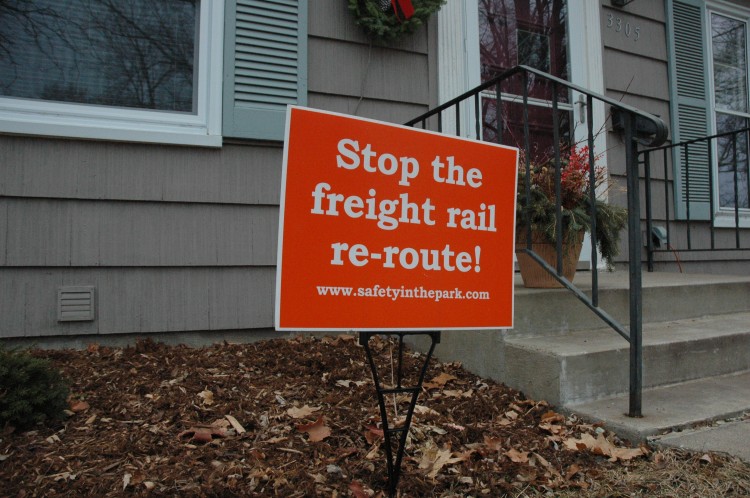On November 14, neighbors gathered on Minnetonka Boulevard outside City Hall with their bright orange “Stop the Freight Rail Reroute” signs held high. Louise Kurzeka was surrounded by her life-long neighbors as they tried to stop rerouting of freight trains through her St. Louis Park neighborhood as part of the plans to expand light rail transit to the southwest metro area.
Kurzeka, a St. Margaret’s class of 1974 graduate, has lived in the same house on Library Lane her whole life. “I actually live in the house that I grew up in. My parents had the house built in 1949. I live 2 blocks from those tracks so I know what the [freight] traffic has been like for all these years…and I know what the negative impact will be,” said Kurzeka.
Dr. Bob Tift, president of Benilde-St. Margaret’s, has spent the last six years as one of three St. Louis Park representatives on the Southwest LRT community advisory council, offering advice on the entire light rail project. Within the last year the size of this committee doubled as more and more people grew concerned about the reroute. “Initially it was probably about 20 people, but now it’s about 40 people. Initially we were a committee that was providing advice to Hennepin County, but then as it moved to the Metropolitan Council they said we should add some representatives of the community,” Dr. Tift said.
Safety in the Park has hired an attorney to help argue their cause, but this has caused the process to move slower and complicated the entire project. “It’s just a lot of vocal angry people that are kind of bullying the whole city and telling everybody nobody wants this. Well that’s just not true…You’ve got one neighborhood that’s really mad, one that’s really happy and then most the people are in between,” Dr. Tift said.
Jamie LaPray serves as co-chair for Safety in the Park, the main organization opposing the reroute. LaPray is worried for the safety issues that would come with putting bigger trains on the current tracks. “We are opposed to rerouting the freight trains from their current location to a lesser used rail line in St. Louis Park. We feel that it is unsafe and expensive to move the trains from where they are now to the tracks in St. Louis Park,” LaPray said.
The popular alternative among opponents of the reroute is co-location, which would keep freight traffic where it is now and build the light rail right next to it. Francis Schmidt, standing outside city hall with the other protesters on November 14, proudly held his handmade sign with the words “Co-location, not relocation” and is very clear on his opinion of the reroute. “The railroad is where it is right now and it works just fine there. And it’ll cost Hennepin County to move it for no reason other than the people that live next to the railroad think the railroad is ugly and we don’t think that we should pay for that,” Schmidt said.
Dr. Tift, however, sees that co-location isn’t the simple, cheap solution most residents hope for. “The DEIS said there’s a place in here where it just cannot co-exist…it’s so narrow that you can’t have the rail traffic, and the light rail traffic, and the bike trail in this real narrow corridor,” Dr. Tift said.
LaPray claims that the freight rail controversy doesn’t exist in a vacuum and has many concerns for the safety of St. Louis Park. “I feel like it’s unsafe for the entire city and it’s going to eventually affect everyone…I live very near the tracks and I like where I live and I don’t want to be living in a situation that’s unsafe,” LaPray said.
For Dr. Tift, he sees that there are other problems that are getting overlooked by this one reroute issue. “There have been six years of discussions and [the reroute] has very rarely been discussed because it’s just one of many issues. They have made this issue like the number one issue but when we met as a group it was one of probably twelve that we considered major things that we need to address,” Dr. Tift said.




































![Teacher Lore: Mr. Hillman [Podcast]](https://bsmknighterrant.org/wp-content/uploads/2025/03/teacherlorelogo-1200x685.png)





